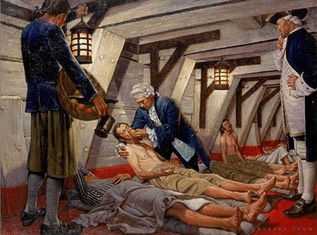Blog
Seamanship
That Sinking Feeling

Go to any boat show, and you will see a multitude of “hull-thumpers.” Watertight integrity does indeed rely on a sound hull, but wait—there’s more…..
Flooding is always a serious matter, but one reason it belongs in the pantheon of “things that went wrong that should not have surprised me” is that most boats are full of holes. Count ’em: propeller shaft, cooling water for the main engine, possibly for a generator, as well. Discharge regulations notwithstanding, a saltwater head functions on water coming and going through holes in the boat. How about a depth sounder? Another hole. A speed log needs a hole, and so does a mechanical bilge pump. Many boats have a saltwater hose for rinsing down. Where does that water come from? A hole…..Many holes are fitted with seacocks that can be closed in the event of a hose failure, so long as you can grab the handle before it submerges. This particular line of defense against flooding raises several points.
A good safety-review article on how to avoid that sinking feeling by Capt. Daniel Parrott at Soundings.
Semper Paratus!
/fl
Politics
Insanity

Here in the panhandle of Florida, we are besieged by the annual late-winter madness known as Mardi Gras. As years go by, it is becoming more difficult to distinguish the nature of a political campaign from a Mardi Gras parade. It seems that most “voters” look to politicians nowadays as someone in costume throwing beads and trinkets into the hands of the screaming mob.
The Biden presidency is a good example!
The reality is that Joe Biden could stand at the door of Fort Knox, throwing out gold bars, and his administration would still be doomed to failure; in the words of Scott Ott, here’s the reason why:
It doesn’t take a rocket scientist to figure out the remedy, or to extrapolate the current trend.
Proverbs 10:8
/fl
Health
The British 'Limeys' Were Right: A Short History of Scurvy
By: Janet A. Aker

Scurvy, a disease caused by lack of vitamin C, sickened sailors who had no access to fresh food supplies, and killed more than 2 million sailors between the 16th and 18th centuries alone.
Scurvy was the scourge of sailors for thousands of years. An estimated 2 million sailors died of the disease between the 16th and 18th centuries alone, often decimating entire ship crews.
Scurvy is a dietary deficiency caused by a lack of vitamin C. The body does not naturally make vitamin C, so it has to come from foods rich in the vitamin such as citrus or from dietary supplements. Before modern refrigeration, sailors on long voyages relied mostly on salted or nonperishable food and had no regular access to fresh green vegetables or fruits that contain the vitamin.
The symptoms of scurvy are dramatic and terrible. In his 1820 textbook on nautical medicine, Navy surgeon Usher Parsons unflinchingly described the signs:
- "The gums become soft, livid and swollen, are apt to bleed from the slightest cause, and separate from the teeth, leaving them loose.
- About the same time the legs swell, are glossy, and soon exhibit foul ulcers.
- The same appearances follow, on other depending parts of the body.
- At first the ulcers resemble black blisters which spread and discharge a dark colored matter. These ulcers increase.
- Emaciation ensues.
- Bleeding occurs at the nose and mouth.
- All the evacuations from the body become intolerably fetid.
- Death closes the scene."
British 'Limeys' and the Cure for Scurvy
The U.S. Navy continued to struggle with scurvy into the 19th century even though the Royal Navy cracked the mystery of the disease in the 18th century thanks to surgeon James Lind. The British began storing citrus fruits on board all of its ships. The British Navy gave its sailors limes or lemon juice rations to ward off scurvy – earning them the nickname of "Limeys" among the American sailors who didn't know about or believe in the preventative treatment.
In his article on the history of scurvy in the U.S. Navy, naval medical historian André Sobocinski, wrote: "In 1809, Dr. William Paul Crillon Barton, a young Philadelphia-born Navy surgeon, took on the fight against scurvy while aboard USS United States, then under the command of Commodore Stephen Decatur. Turning to the medical literature out of Great Britain, Barton administered a citrus concoction to the most severely affected crew members and curing them of their symptoms."
Over the ensuing years Barton was the leading figure in the fight against scurvy. He lobbied the Secretary of the Navy and ship captains with what he described as a "clarified lemon-lime ration."
Despite Barton's success, "the decision to adopt vitamin C-rich rations would remain in the hands of individual fleet commanders, ship captains, and their consulting surgeons for well into the nineteenth century. And even if a ship did take necessary preventive measures against scurvy, long deployments could exhaust shipboard provisions leading to a host of nutritional diseases like scurvy," Sobocinski wrote.
The Navy Today
Scurvy, of course, is not a problem for today's Navy.
Jennifer Person, program manager and dietitian for the Navy Food Service, said there are many items on Navy menus to prevent the disease. For example, she said:
- Food service personnel are encouraged to provide 2.5 cups of vegetables and two cups of fruit daily to service members.
- Foods containing vitamin C are abundant.
- Navy menus include a combination of fresh, frozen, and canned fruits and vegetables.
- Vegetables and fruits offered include oranges, red peppers, kiwi, strawberries, broccoli, cantaloupe, tomatoes, potatoes, cauliflower, Brussel sprouts, kale, lemons, and grapefruit juice.
- Many more vitamin C options are available in a wide range of flavors that make it easy for sailors with different preferences to get their daily requirement.
"Leaders across the DOD recognize the importance of fueling our service members for performance with quality foods," Person said. "Galley menus are written according to DOD Menu Standards for Human Performance Optimization that ensure an array of foods are provided daily."
Scurvy Hasn't Gone Away Altogether
Today, scurvy still occurs in developed countries despite the widespread availability of multiple enriched and fortified foods.
According to the National Institutes of Health, those most at risk for scurvy are:
- living alone
- institutionalized with diets devoid of fresh fruits and vegetables
- missing teeth or toothless
- showing poor self-care
- lacking social support
- displaying destructive behaviors such alcoholism, drug abuse, or smoking
- mentally or chronically ill
Article Source: Thanks to Health.mil
Time to pick up another half-gallon of Florida Orange Juice!
/fl
Seamanship
Rounding the Mark
Winter sailing on Pensacola Bay:
The VX One Winter Series #1 Day 1 Race 4. First mark rounding... 33 boats rounded in 1 1/2 minutes.
A variety of skill and teamwork in evidence by the crews as they round the mark and deploy their spinnakers. A great way to spend a winter day!
/fl
American Society
Freedom and Accountability
It matters not to the gun, but people enjoy freedom.
18.5 Million Americans Bought Guns in 2021
"The fact that over 18.5 million Americans chose to lawfully purchase a firearm in 2021 is indicative of the value Americans hold of the Second Amendment right to keep and bear arms,"
And, I greatly suspect that all but a very, very, small number of those 18.5 million people mentioned in the above article respect the personal accountability that goes with their freedom. That’s an important part of the concept that a vociferous few don’t seem to get.
/fl
